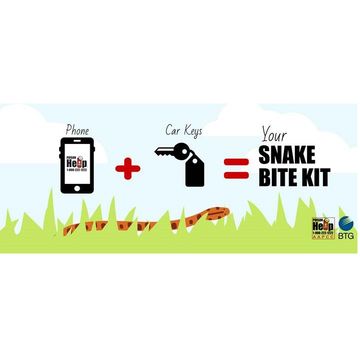New Mexico Approves Master of Science in Anesthesia Program at UNM

NM Poison Center Injects Urgency into Snake Season
New Apps, Fresh Campaign Target State
During the summer months, when snakes are out-and-about, the New Mexico Poison & Drug Information Center wants you to make your smart phone a little smarter by adding the SnakeBite911 app.
"Please take a minute to prepare yourself for the outdoors," urges center educator Jacqueline Kakos. "If you have the poison center number and this new app in your cell phone, you're well equipped with the latest information for emergency support for a rattlesnake bite."
The SnakeBite911 app offers emergency support for snakebites, including a quick-dial 911 feature, a checklist of actions to avoid, a time-stamped venom tracker and a hospital locator for the quickest access to anti-venom.
"There's so much bad information out there about how to respond to a rattlesnake bite in the field," Kakos says. "Slicing open tissue at the bite site and sucking out the venom does no good, nor does applying a tourniquet. In fact, they can make things worse. The best reaction to a bite is to keep calm and dial 911."
The app, available through Apple's App Store and Google Play, also offers important information about rattlesnakes and other North American pit vipers, including how to identify them and how to avoid being bitten. There's even a snake sighting map to show (and add) local sightings.
According to the center, August is New Mexico's peak month for rattlesnake activity. Last year, 59 rattlesnake bites were reported in 17 New Mexico counties. Bernalillo County accounted for approximately 25 percent of them, but Doña Ana, Eddy, San Juan and Santa Fe counties saw their share.
Twenty-three New Mexicans have suffered rattlesnake bites so far this year - up nearly 15 percent from this time last year. Coupled with an increase in scorpion stings in the summer of 2017, the poison center is busy educating and equipping residents to more safely enjoy the bounty of New Mexico's outdoors.
In addition to the consumer version, "SnakeBite911 FR" is designed for first-responders, adding to the consumer version a checklist of actions to avoid, pre-treatment steps to take and a venom tracker feature. "SnakeBite911 ER" for emergency room health care professionals adds even more features, like a treatment algorithm, alerts for next treatment steps and more.
"Poisonings, including rattlesnake bites, are the second leading cause of unintentional injury death in New Mexico," Kakos says. "Last year we took nearly 24,000 calls from people of all ages in all types of poisoning situations."
The New Mexico Poison & Drug Information Center also works with webPOISONCONTROL®, an online triage tool and app that guide users faced with a poison emergency through a series of simple questions to determine the toxicity. It helps users decide what to do when substances are swallowed, splashed in the eye or on the skin, inhaled or injected.
Finally, text "vcard toxic" to 313131 and download the New Mexico Poison & Drug Information Center contact information. "It only takes a minute, and you've created instant access to poison experts in an emergency situation," Kakos says.